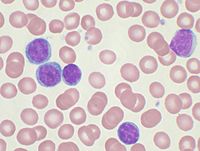
Photo from wikipedia
We used radiomics feature–based machine learning classifiers of apparent diffusion coefficient (ADC) maps to differentiate small round cell malignant tumors (SRCMTs) and non-SRCMTs of the nasal and paranasal sinuses. A… Click to show full abstract
We used radiomics feature–based machine learning classifiers of apparent diffusion coefficient (ADC) maps to differentiate small round cell malignant tumors (SRCMTs) and non-SRCMTs of the nasal and paranasal sinuses. A total of 267 features were extracted from each region of interest (ROI). Datasets were randomized into two sets, a training set (∼70%) and a test set (∼30%). We performed dimensional reductions using the Pearson correlation coefficient and feature selection analyses (analysis of variance [ANOVA], relief, recursive feature elimination [RFE]) and classifications using 10 machine learning classifiers. Results were evaluated with a leave-one-out cross-validation analysis. We compared the AUC for all the pipelines in the validation dataset using FeAture Explorer (FAE) software. The pipeline using RFE feature selection and Gaussian process classifier yielded the highest AUCs with ten features. When the “one-standard error” rule was used, FAE produced a simpler model with eight features, including Perc.01%, Perc.10%, Perc.90%, Perc.99%, S(1,0) SumAverg, S(5,5) AngScMom, S(5,5) Correlat, and WavEnLH_s-2. The AUCs of the training, validation, and test datasets achieved 0.995, 0.902, and 0.710, respectively. For ANOVA, the pipeline with the auto-encoder classifier yielded the highest AUC using only one feature, Perc.10% (training/validation/test datasets: 0.886/0.895/0.809, respectively). For the relief, the AUCs of the training, validation, and test datasets that used the LRLasso classifier using five features (Perc.01%, Perc.10%, S(4,4) Correlat, S(5,0) SumAverg, S(5,0) Contrast) were 0.892, 0.886, and 0.787, respectively. Compared with the RFE and relief, the results of all algorithms of ANOVA feature selection were more stable with the AUC values higher than 0.800. We demonstrated the feasibility of combining artificial intelligence with the radiomics from ADC values in the differential diagnosis of SRCMTs and non-SRCMTs and the potential of this non-invasive approach for clinical applications. • The parameter with the best diagnostic performance in differentiating SRCMTs from non-SRCMTs was the Perc.10% ADC value. • Results of all the algorithms of ANOVA feature selection were more stable and the AUCs were higher than 0.800, as compared with RFE and relief. • The pipeline using RFE feature selection and Gaussian process classifier yielded the highest AUC.
Journal Title: European Radiology
Year Published: 2022
Link to full text (if available)
Share on Social Media: Sign Up to like & get
recommendations!